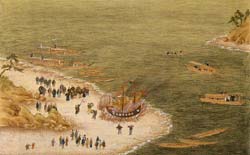Wednesday, August 26, 2015
Wednesday, August 19, 2015
Guangxiao Temple 光孝寺 in Guangzhou
Guangxiao Temple in Guangzhou is a very important monastery in the history of Chinese Buddhism. It used to be called Zhizhi Temple 制旨寺 in the Tang dynasty. Many famous Buddhist scriptures such as the Surangama Sutra 楞嚴經 were translated here. A memorial pagoda was built for the sixth Chan patriarch Huineng 慧能 in the temple because Huineng had stayed here and had a famous debate about Chan teaching. During the Ming-Qing transition, the Caodong master Tianran Hanshi 天然函昰 was the abbot and revived the temple.
Wednesday, August 12, 2015
The Spirit Boat Procession (Shōrō nagashi 精霊流し) in Nagasaki

It is Obon お盆 festival in Japan again. Two years ago, I arrived Nagasaki during Obon and learned the Nagasaki style is the Spirit Boat Procession (Shōrō nagashi 精霊流し) influenced by the Chinese residents there. Dr. Yang Kueihsiang told me that it was also called Color Boat Procession 彩舟流し(さいしゅうながし)and can be found in Nagasaki historical records. During the festival, the Rite of Feeding Hungry Ghost would be performed. It is possible that master Yinyuan had participated in these festivals during his stay in Nagasaki because he practiced the Rite of Feeding Hungry Ghosts (Shishi 施食, Shi E'gui 施餓鬼, Fang Yankou 放焰口) in his Obaku monasteries as well. I have a short discussion in my book Leaving for the Rising Sun, page 152.
It is now also part of the popular culture. Sada Masashi's first famous song was written for this festival when he was in Nagasaki.
Friday, August 7, 2015
Haizhuang Temple 海幢寺 in Guangzhou
 |
| Haichuang Gate, shot by Jiang Wu |
What I don't know is its connection with Guangzhou Foreign communities because it faced Pearl River and the port. Before the Opium War, this was the only scenic spot in the city open to the foreigners. Therefore, it was figured in many European publications about China around the time. Foreign residences and modern societies were developed around this temple.
 The Old Haichuang Temple around 1840s. From China Illustrated, painted by Thomas Allom, 1843. 中譯 |
| 《大清帝国城市印象》2002年上海古籍出版社出版 |
Wednesday, August 5, 2015
Kindle Version of Leaving for the Rising Sun
I am glad that Oxford published the Kindle version of Leaving for the Rising Sun. Oxford also released a Kindle version of my first book Enlightenment in Dispute. Kindle is a widely used reading device from Amazon. It is now indispensable for any serious readers. You can also send files such as student works and conference papers to Kindle for reading leisurely. I don't know if these Kindle versions are available in China and Japan.
Subscribe to:
Posts (Atom)






